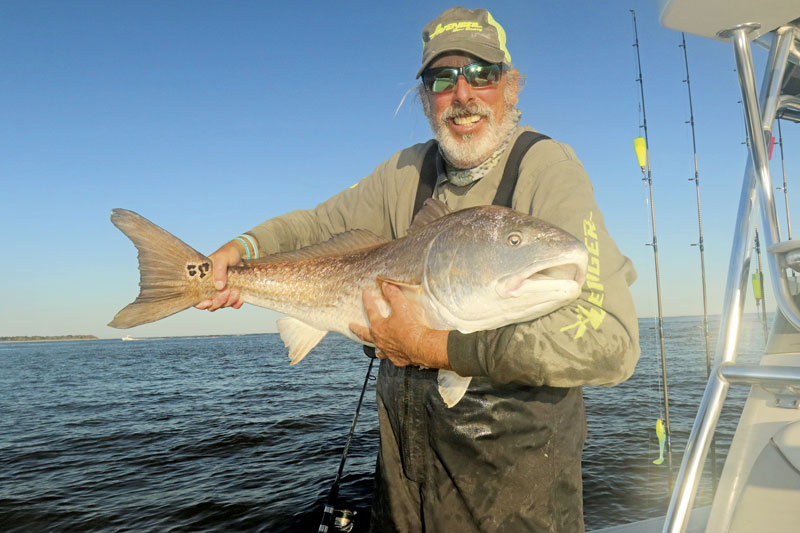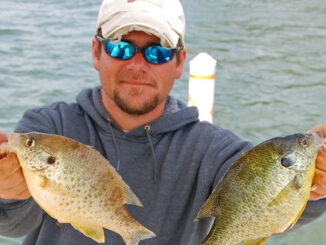
Artificial lures are great for inshore species
In many ways, it’s tough to beat live bait when fishing for any number of inshore species.
But artificial lures can be just as deadly, and in some cases, even more so, as long as the angler knows what they’re doing.
And artificial lures have one big advantage compared to live bait that can’t be overlooked. That advantage is time.
Capt. Rob Bennett of Kiawah Inshore Charters fishes with both live bait and artificial lures. But when the bite is at its hottest, he said artificial lures are the way to go.
For an example of this, he stood on the deck of his boat, casting a jighead paired with a Z-Man Slim SwimZ to a small section of water around a dense shell bank. For a dozen casts in a row, every time his lure hit the water, it was hit hard by a speckled trout. In the amount of time it took him to unhook one trout and make another cast, a live bait angler would still be getting a shrimp or mud minnow threaded onto their hook.
“When the bite is really hot, you can catch three, four fish with an artificial lure, compared to one fish with live bait. It’s just quicker when you don’t have to rebait your hook with every fish,” he said.

He repeated the same process later that day while pitching the same lure under a dock, where hungry redfish were waiting to pounce at the sheer presence of his lure.
“If you’re spending time dealing with live bait when the bite is like this, you’re wasting time and missing out on fish,” he said.
Using artificial lures also cuts down on the hassle of gathering live bait and keeping it alive.
“On some days, and during certain times of the year, live bait is really necessary. But during the fall, you can leave the dock on most days with just artificial lures and catch more fish than you would if you were spending time buying or catching bait, then taking the time to put a new live shrimp or mud minnow on each time you reel in a fish,” said Bennett (843-367-3777).
When using lures like the Slim SwimZ, Bennett focuses on shell banks, boat docks, rock walls and deep drop-offs. He uses a fluorocarbon leader, which he said is especially necessary in the fall when the water is typically very clear.
Pop it
And convenience isn’t the only reason many anglers prefer artificial lures over live bait. Capt. Rod Thomas of Captain Ponytail Guide Service (336-240-5649) can attest to that.
Thomas has spent a lot of time over the years fishing for bull redfish in NC’s Pamlico Sound and SC’s Winyah Bay. Using large pieces of cut mullet on the bottom is the old standby method that most anglers use for this type of fishing. But he’s got another trick up his sleeve that points to another reason that gets anglers excited about fishing with artificial lures.

“It’s just a lot more fun. I’ve got clients that have never fished artificial lures before, and I’ve helped them catch old drum up to 40 inches long and bigger, with both live bait and on artificial swimbaits. They’ll all tell you that they’d take one of those big fish on the artificial lure for 10 on live bait,” he said. “It really is just that much more fun.”
His go-to artificial rig is a 5-inch long Z-Man swimbait fished under a popping cork.
One reason it’s more enjoyable for many anglers is because it’s a much more active type of fishing. With live bait, anglers mostly make a cast, put the rod in a rod holder, then wait. And one thing they miss when fishing that way is the initial strike of the fish. They also miss the sensation that they are actively involved in the process.
Walk it
Thomas uses this technique in open water that is near jetties or other types of structure. He said another reason anglers like it so much is because of the visual nature.

“You don’t see the lure when fishing like this, but you can watch the popping cork. And when one of these big fish hits, the vision of seeing that cork rocket underwater is a thrill. Sometimes you’ll see it before you feel the fish on the line. It gives anglers a combination of sensations when they catch a fish this way,” he said.
This visual appeal is also what attracts many anglers to using topwater lures for inshore fish. Walk-the-dog type lures like the Berkley Cane Walker, the Heddon Spook Jr., and the MirrOLure Top Dog are all great choices. These are highly effective on speckled trout, and redfish will also hit them hard, especially in the early morning hours.
Swim it, spin it
Anglers who fish for bass in freshwater will take to this type of fishing quite easily, because it’s basically the same thing. Casting close to rock walls, shell banks, and over submerged oyster rakes and rocky points, the angler does a simple twitch-pause-twitch action while slowly reeling in the slack line, watching the lure the whole way. Violent strikes happen often when the fish are feeding aggressively, and it’s just as much fun to watch when they’re swiping at it more passively.

When the fish are a little deeper, or when they seem to shy away from surface activity, those same swimbaits Thomas uses under popping corks can also be fished without the cork. They run at any depth of the water column, depending on how fast or slow the angler retrieves it. The weight of the jighead also comes into play, and can aid in making long-distance casts. It’s a good way to find what depth the fish are feeding, if they’re not coming to the top.
One of the most overlooked types of artificial lures among inshore anglers is the spinning lure. The Redfish Magic is one that’s well-known in the circle of anglers who do partake. But inline spinners like the Mepps Aglia or Black Fury can be just as deadly, and are especially effective during the slacker tide periods. Like cork-less swimbaits, spinners can be retrieved at any depth, depending on the speed of retrieval, but the blades add sound and vibration, and sometimes that can trigger strikes when little else is working.
The question of which artificial lure is best for inshore use doesn’t have a straightforward answer. What works one day may not work so well the next. It’s just like any other fishing; it depends on the conditions and the fickleness of the fish. But as long as anglers have a few of the different types of lures mentioned above, and are willing to perform some trial and error, they’ll find a winning combination.
Artificial lures for bottom anglers
Sometimes it’s nice to take a break from casting and cranking, and even to kick back and have a snack on the water. Anglers can still keep some bait in the water without the hassle of keeping live shrimp or baitfish alive.
Berkley’s Surf Bites are made up of their Gulp! formula and infused with scent and taste that attract a variety of inshore gamefish. They’re very durable and able to withstand bait thieves and aggressive hits. And like all Gulp! products, they can be recharged simply by placing them back in their original bags.
Surf bytes come in long strips that can be cut to the desired size. They are available in several different colors/flavors, and can be fished on jigheads, freelined, or on Carolina rigs.





Be the first to comment